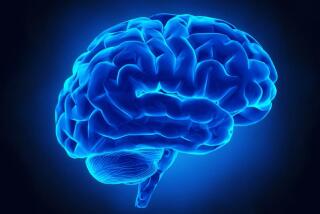Nuns donate their brains to Alzheimer’s research
- Share via
Catholic nuns are known for their acts of charity, but Sister Adrienne Schmidt has found a way to give beyond the grave: She will donate her brain to science.
First, though, she is exercising it in an annual battery of memory tests administered by researchers at Chicago’s Rush University. Schmidt, 82, repeats two-digit numbers, then three, four, five, six and seven digits. She names as many animals as she can in a minute. She listens to a 30-second story about a school cafeteria cook who is robbed of $56. Half an hour later, she must repeat as many details as she can.
The yearly tests are designed to provide a history of how her brain is aging. When the time comes, Schmidt’s brain will join hundreds of others in 38 cooling units in a laboratory at the school’s medical center.
Schmidt is one of the original participants in Rush University’s Religious Orders Study, which began in 1993. It is one of a handful of studies nationwide that uses donated brains with a rich and detailed clinical history gleaned from years of memory tests and physical exams. Funding for the study is slated to run out next year, but researchers are preparing a federal grant proposal in hopes of extending the study five years, because it continues to yield a bounty of results.
The brains — more than 850 of them — are part of a treasure trove of physical specimens and data shedding light on Alzheimer’s disease. The research depends on elderly volunteers, many of whom are members of Catholic religious orders, who agree to annual tests detailing the state of their memory as age. They also must be willing to give a big part of themselves when they die.
Schmidt, of the Congregation of St. Joseph in La Grange Park, Ill., said some of the other sisters were a bit squeamish about donating their brains.
“You know, what’s my brain going to do once I’m gone anyway?” she said. “It’s ceased.”
The study’s goal is to track cognitive decline in old age and identify risk factors for Alzheimer’s. Researchers gain an understanding of how the participants live their lives — including how much they exercise and what they eat. Later, they examine the condition of their brains, such as the shape of the cortex’s undulating ridges, or gyri, and the accumulation of destructive proteins in tiny brain cells.
The researchers sought members of religious orders, hoping they would be willing to donate and would not have children or spouses interfering with that arrangement at the last minute. More than 1,100 nuns, priests and brothers across the country representing a wide range of ethnic groups are taking part.
An on-call rapid autopsy team collects the brains from donors often within as few as four hours of death to avoid degradation. .
Last year, the National Institutes of Health awarded Rush University about $5.5 million in grants to study how epigenetic changes — chemical modifications to genes that can result from diet, aging, stress or environmental exposure — contribute to memory formation and cognitive decline. Rush researchers hypothesize that the brain might be using those epigenetic marks to store memories.
One of the studies’ more remarkable findings has been a concept neurologist David Bennett, director of the school’s Alzheimer’s Disease Center, calls neural reserve. Almost a third of the participants who died without demonstrating any marked memory loss exhibited hallmarks of Alzheimer’s when their brains were examined by neuropathologists using high-powered microscopes. The signals — the buildup of amyloid plaques and neurofibrillary tangles, which cause the death of neurons — are used to confirm an Alzheimer’s diagnosis.
Neural reserve seemed to correlate largely with highly educated and socially and physically active people, Bennett said. Thus, he said, it may be possible to delay the onset of Alzheimer’s symptoms by “building a better brain through your life experiences.”
“Why were their brains so robust?” said Melanie Chavin, vice president of program services at the Greater Illinois chapter of the Alzheimer’s Assn. “What were they doing right? If we can find that out, that can be the seeds of some prevention.”
Alzheimer’s, the most common form of dementia, affects about 5.3 million Americans and is the nation’s seventh-leading cause of death, according to the national Alzheimer’s Assn., which is based in Chicago. The number of cases is rising as Americans live longer from healthier lifestyles and improved healthcare, and it is expected to keep climbing as baby boomers reach old age.






